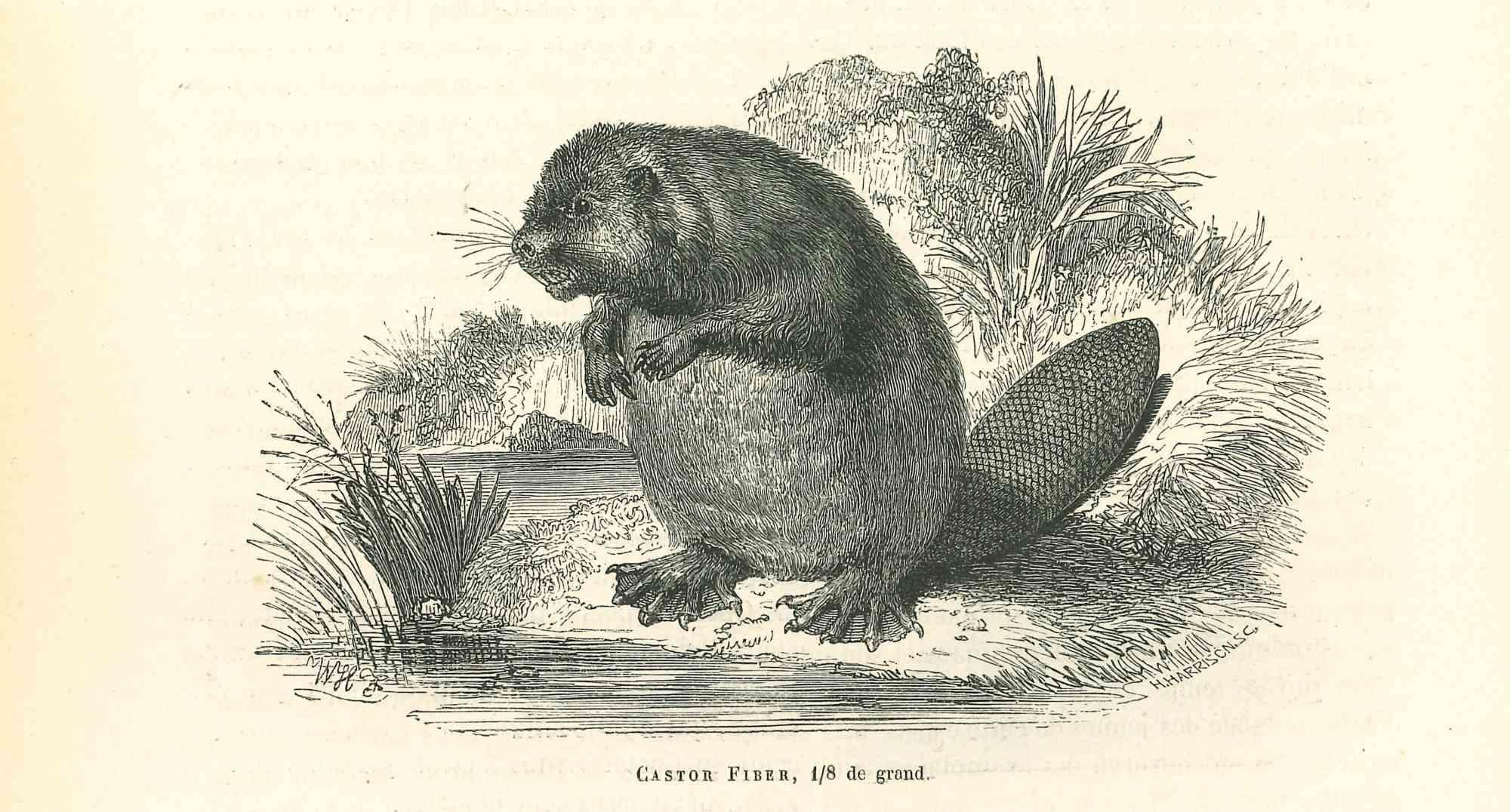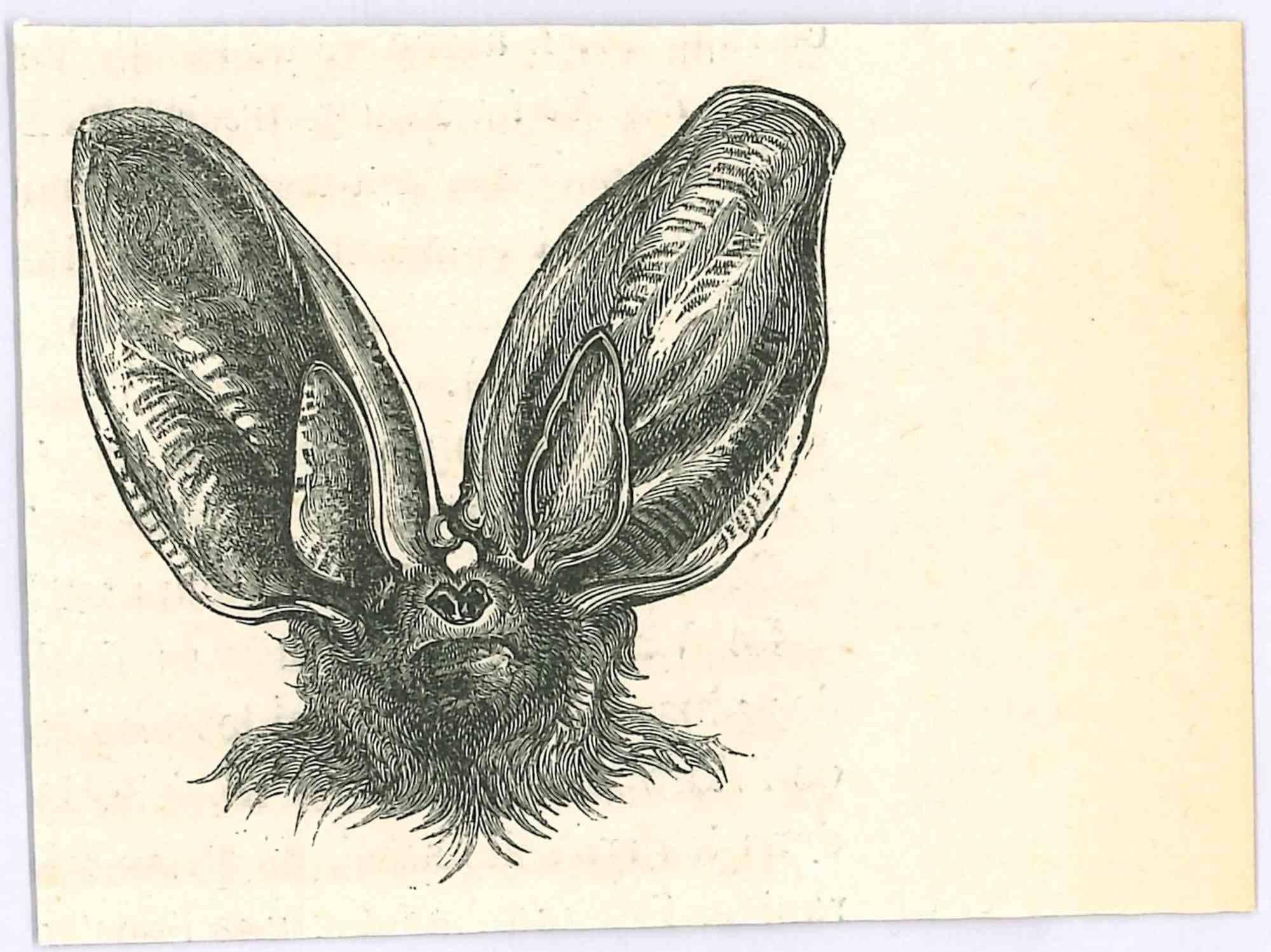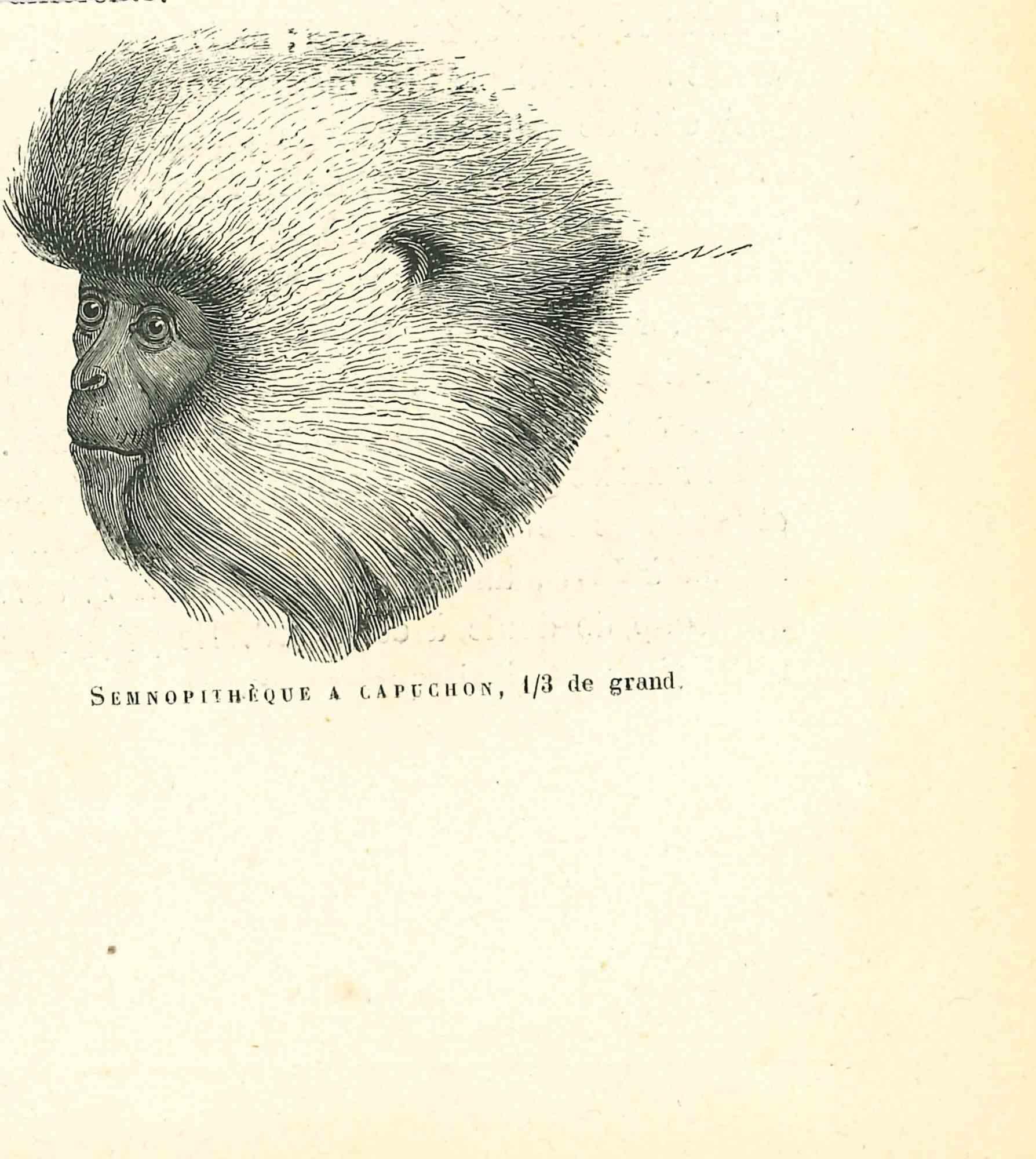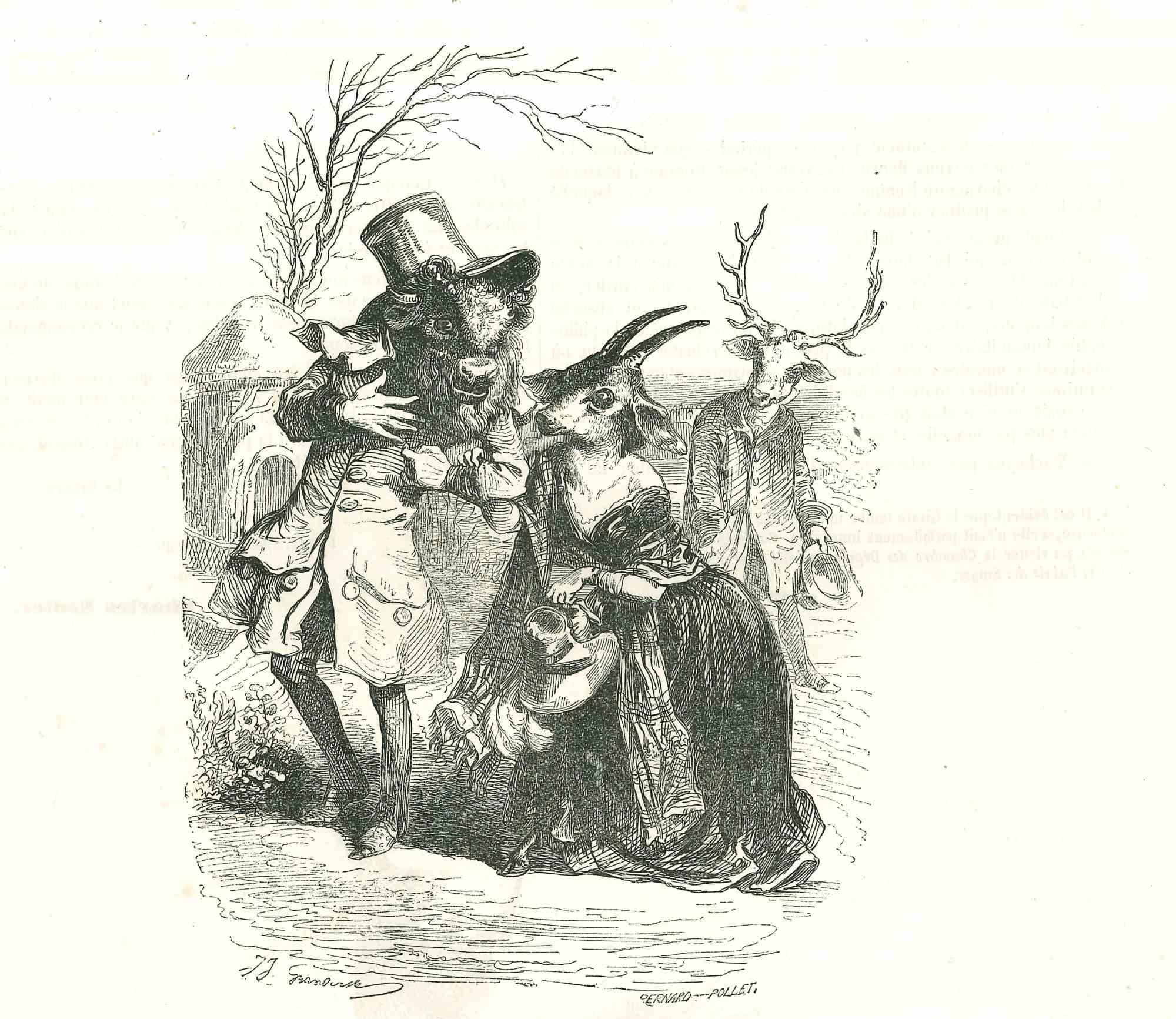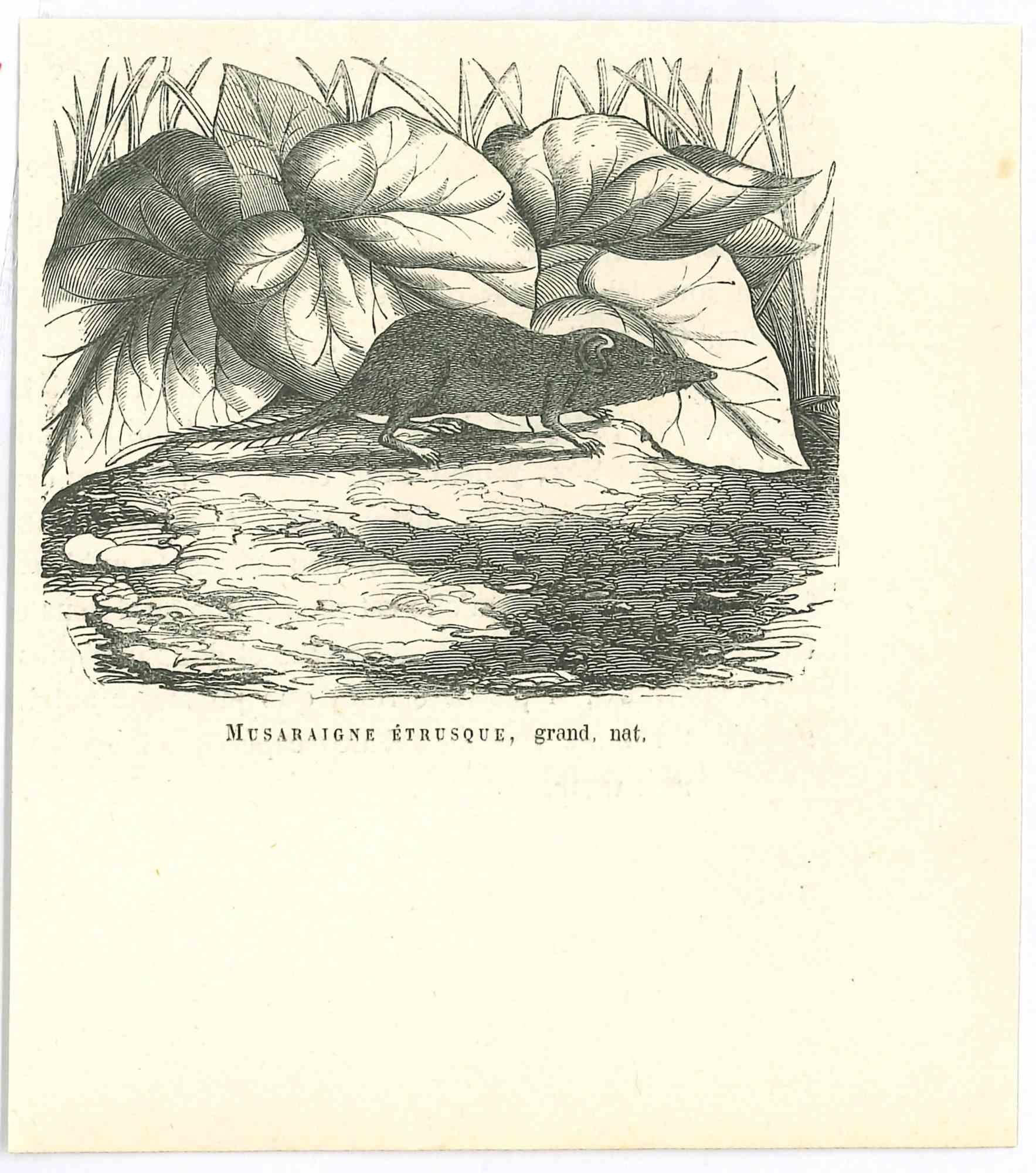Items Similar to Mr. Monkey Painter Set Off - Original Lithograph by J.J Grandville - 1852
Want more images or videos?
Request additional images or videos from the seller
1 of 2
Jean Jeacques GrandvilleMr. Monkey Painter Set Off - Original Lithograph by J.J Grandville - 18521852
1852
About the Item
Mr.Monkey Painter Set Off is an original lithograph on ivory-colored paper realized by J.J. Grandville from Scènes de la vie privée et publique des animaux, 1852. Published by Manesq & Harvard, Paris.
Monogrammed on the Plate.
Good Conditions.
With the note in French on the rear.
The artwork illustrated animal fable by delicate and precise strokes, through wonderful imagination and sensibility, featuring animals that behave and speak as human beings to highlight human follies and weaknesses. A moral and amusing lesson for behavior is woven into the story. Wonders and mysterious animal life are expressed through the amazing human mind of Jean Ignace Isidore Gérard (J.J. Grandville) and the potential of illusion and conception of the world admirably.
Jean Ignace Isidore Gérard (13 September 1803, Nancy, Meurthe-et-Moselle – 17 March 1847, Vanves), generally known by the pseudonym of Jean-Jacques or J. J. Grandville, was a French caricaturist. Grandville received his first instruction in drawing from his father, a painter of miniatures. At the age of twenty-one he moved to Paris, and soon afterwards published a collection of lithographs entitled Les Tribulations de la petite proprieté. He followed this with Les Plaisirs de tout âge and La Sibylle des salons (1827); but the work which first established his fame was Les Métamorphoses du jour (1828–29), a series of seventy scenes in which individuals with the bodies of men and faces of animals are made to play a human comedy. These drawings are remarkable for the extraordinary skill with which human characteristics are represented in animal facial features.
After the reinstitution of prior censorship of caricature in 1835, Grandville turned almost exclusively to book illustration, supplying illustrations for various standard works, such as the songs of Béranger, the fables of La Fontaine, Don Quixote, Gulliver's Travels, Robinson Crusoe. He also continued to issue various lithographic collections, among which may be mentioned La Vie privée et publique des animaux, Les Cent Proverbes, Un Autre Monde and Les Fleurs animées.
Though the designs of Grandville are occasionally unnatural and absurd, they usually display keen analysis of character and marvellous inventive ingenuity, and his humour is always tempered and refined by delicacy of sentiment and a vein of sober thoughtfulness. He died on 17 March 1847 and is buried in the Cimetière Nord of Saint-Mandé just outside Paris. A short notice of Grandville appears in Théophile Gautier's Portraits contemporains.
See also Charles Blanc, Grandville (Paris, 1855)-
- Creator:
- Creation Year:1852
- Dimensions:Height: 5.32 in (13.5 cm)Width: 3.75 in (9.5 cm)Depth: 0.04 in (1 mm)
- Medium:
- Movement & Style:
- Period:
- Condition:Insurance may be requested by customers as additional service, contact us for more information.
- Gallery Location:Roma, IT
- Reference Number:
About the Seller
4.9
Platinum Seller
These expertly vetted sellers are 1stDibs' most experienced sellers and are rated highest by our customers.
1stDibs seller since 2017
6,757 sales on 1stDibs
Typical response time: 2 hours
- ShippingRetrieving quote...Ships From: Monaco, Monaco
- Return PolicyA return for this item may be initiated within 14 days of delivery.
More From This SellerView All
- Gastor Fiber - Lithograph by Paul Gervais - 1854By Paul GervaisLocated in Roma, ITGastor Fiber is an original lithograph on ivory-colored paper, realized by Paul Gervais (1816-1879). The artwork is from The Series of "Les Trois Règnes de la Nature", and was publis...Category
1850s Modern Animal Prints
MaterialsLithograph, Paper
- The Bat -Lithograph by Paul Gervais - 1854By Paul GervaisLocated in Roma, ITThe Bat is an original lithograph on ivory-colored paper, realized by Paul Gervais (1816-1879). The artwork is from The Series of "Les Trois Règnes de la Nature", and was published i...Category
1850s Modern Animal Prints
MaterialsLithograph, Paper
- The Skull - Original Lithograph by Paul Gervais - 1854By Paul GervaisLocated in Roma, ITThe Skull is an original lithograph on ivory-colored paper, realized by Paul Gervais (1816-1879). The artwork is from The Series of "Les Trois Règnes de la Nature", and was published...Category
1850s Modern Animal Prints
MaterialsLithograph, Paper
- The Monkey - Lithograph by Paul Gervais - 1854By Paul GervaisLocated in Roma, ITThe Monkey is an original lithograph on ivory-colored paper, realized by Paul Gervais (1816-1879). The artwork is from The Series of "Les Trois Règnes de la Nature", and was publishe...Category
1850s Modern Animal Prints
MaterialsLithograph, Paper
- Mr.Ox Flirting with Miss.Goat - Original Lithograph by J.J Grandville - 1852By Jean Jeacques GrandvilleLocated in Roma, ITMr.Ox Flirting With Miss.Goat is an original lithograph on ivory-colored paper realized by J.J. Grandville from Scènes de la vie privée et publique des animaux, 1852. Published by Ma...Category
1850s Modern Animal Prints
MaterialsLithograph, Paper
- The Mouse - Lithograph by Paul Gervais - 1854By Paul GervaisLocated in Roma, ITThe Mouse is an original lithograph on ivory-colored paper, realized by Paul Gervais (1816-1879). The artwork is from The Series of "Les Trois Règnes de la N...Category
1850s Modern Animal Prints
MaterialsLithograph, Paper
You May Also Like
- 'Equestrian Actress', Modernism, Circus, Vietnamese, French, Horse, AcrobatsBy Hoi LebadangLocated in Santa Cruz, CASigned lower right, 'Lebadang' and with number and limitation, 163/215, lower left. Also known as Dang Lebadang (Vietnamese-French, 1922-2015) this not...Category
1960s Modern Animal Prints
MaterialsPaper, Lithograph
- Original Lithograph Horse Anatomy Leonardo Davinci Nude Male Figure Sepia SignedBy Claude WeisbuchLocated in Milwaukee, WI"Homage a Leonardo d'Vinci (Leonardo drawing, 3 Figures, Horse from De La Bataille Vol. I)" is an original color lithograph signed by Claude Weisbuch. A group of figures stand to the...Category
1970s Modern Figurative Prints
MaterialsPaper, Lithograph
- The Human Comedy - LithographBy (after) Pablo PicassoLocated in Collonge Bellerive, Geneve, CHAfter Pablo Picasso The Human Comedy - Lithograph after an original drawing, as published in the journal "Verve" Printed signature and date Dimensi...Category
1950s Modern Figurative Prints
MaterialsLithograph
- The Human Comedy - LithographBy (after) Pablo PicassoLocated in Collonge Bellerive, Geneve, CHAfter Pablo Picasso The Human Comedy - Lithograph after an original drawing, as published in the journal "Verve" Printed signature and date Dimensions...Category
1950s Modern Animal Prints
MaterialsLithograph
- Enrico Baj - LithographBy Enrico BajLocated in Collonge Bellerive, Geneve, CHEnrico Baj - Original Lithograph Colorful Abstraction 1962 From the art revue XXe Siecle Dimensions: 32 x 24 Edition: G. di San Lazzaro. Unsigned and unumbered as issuedCategory
1960s Modern Figurative Prints
MaterialsLithograph
- Le Christ a l'Horloge, ParisBy Marc ChagallLocated in Missouri, MOMarc Chagall "Le Christ a l'Horloge, Paris" (Christ in the Clock) 1957 (M. 196) Color Lithograph on Arches Wove Paper Signed in Pencil "Marc Chagall" Lower Right Initialed "H.C." (Hors Commerce) Lower Left, aside from numbered edition of 90 *Floated in Gold Frame with Linen Matting, UV Plexiglass Sheet Size: 18 3/4 x 14 3/4 inches (47.5 cm x 38 cm) Image Size: 9 3/4 x 8 1/2 inches Framed Size: 28.5 x 24.25 inches Marc Chagall was a man of keen intelligence, a shrewd observer of the contemporary scene, with a great sympathy for human suffering. He was born on July 7, 1887 in Vitebsk, Russia; his original name was Moishe Shagal (Segal), but when he became a foremost member of the Ecole de Paris, he adopted French citizenship and the French spelling of his name. Vitebsk was a good-sized Russian town of over 60,000, not a shtetl. His father supported a wife and eight children as a worker in a herring-pickling plant. Sheltered by the Jewish commandment against graven images, the young Chagall never saw so much as a drawing until, one day, he watched a schoolmate copying a magazine illustration. He was ridiculed for his astonishment, but he began copying and improvising from magazines. Both Chagall's parents reluctantly agreed to let him study with Yehuda Pen, a Jewish artist in Vitebsk. Later, in 1906, they allowed their son to study in St. Petersburg, where he was exposed to Russian Iconography and folk art. At that time, Jews could leave the Pale only for business and employment and were required to carry a permit. Chagall, who was in St. Petersburg without a permit, was imprisoned briefly. His first wife, Bella Rosenfeld, was a product of a rich cultivated and intellectual group of Jews in Vitebsk. Chagall was made commissar for the arts for the area, charged with directing its cultural life and establishing an art school. Russian folklore, peasant life and landscapes persisted in his work all his life. In 1910 a rich patron, a lawyer named Vinaver, staked him to a crucial trip to Paris, where young artists were revolutionizing art. He also sent him a handsome allowance of 125 francs (in those days about $24) each month. Chagall rejected cubism, fauvism and futurism, but remained in Paris. He found a studio near Montparnasse in a famous twelve-sided wooden structure divided into wedge-shaped rooms. Chaim Soutine, a fellow Russian Jew, and Modigliani lived on the same floor. To Chagall's astonishment, he found himself heralded as one of the fathers of surrealism. In 1923, a delegation of Max Ernst, Paul Eluard and Gala (later Salvador Dali's wife) actually knelt before Chagall, begging him to join their ranks. He refused. To understand Chagall's work, it is necessary to know that he was born a Hasidic Jew, heir to mysticism and a world of the spirit, steeped in Jewish lore and reared in the Yiddish language. The Hasidim had a special feeling for animals, which they tried not to overburden. In the mysterious world of Kabbala and fantastic ancient legends of Chagall's youth, the imaginary was as important as the real. His extraordinary use of color also grew out of his dream world; he did not use color realistically, but for emotional effect and to serve the needs of his design. Most of his favorite themes, though superficially light and trivial, mask dark and somber thoughts. The circus he views as a mirror of life; the crucifixion as a tragic theme, used as a parallel to the historic Jewish condition, but he is perhaps best known for the rapturous lovers he painted all his life. His love of music is a theme that runs through his paintings. After a brief period in Berlin, Chagall, Bella and their young daughter, Ida, moved to Paris and in 1937 they assumed French citizenship. When France fell, Chagall accepted an invitation from the Museum of Modern Art to immigrate to the United States. He was arrested and imprisoned in Marseilles for a short time, but was still able to immigrate with his family. The Nazi onslaught caught Chagall in Vichy, France, preoccupied with his work. He was loath to leave; his friend Varian Fry rescued him from a police roundup of Jews in Marseille, and packed him, his family and 3500 lbs. of his art works on board a transatlantic ship. The day before he arrived in New York City, June 23, 1941, the Nazis attacked Russia. The United States provided a wartime haven and a climate of liberty for Chagall. In America he spent the war years designing large backdrops for the Ballet. Bella died suddenly in the United States of a viral infection in September 1944 while summering in upstate New York. He rushed her to a hospital in the Adirondacks, where, hampered by his fragmentary English, they were turned away with the excuse that the hour was too late. The next day she died. He waited for three years after the war before returning to France. With him went a slender married English girl, Virginia Haggard MacNeil; Chagall fell in love with her and they had a son, David. After seven years she ran off with an indigent photographer. It was an immense blow to Chagall's ego, but soon after, he met Valentine Brodsky, a Russian divorcee designing millinery in London (he called her Fava). She cared for him during the days of his immense fame and glory. They returned to France, to a home and studio in rustic Vence. Chagall loved the country and every day walked through the orchards, terraces, etc. before he went to work. Chagall died on March 28, 1985 in the south of France. His heirs negotiated an arrangement with the French state allowing them to pay most of their inheritance taxes in works of art. The heirs owed about $30 million to the French government; roughly $23 million of that amount was deemed payable in artworks. Chagall's daughter, Ida and his widow approved the arrangement. Written and submitted by Jean Ershler Schatz, artist and researcher from Laguna Woods, California. Sources: Hannah Grad Goodman in Homage to Chagall in Hadassah Magazine, June 1985 Jack Kroll in Newsweek, April 8, 1985 Andrea Jolles in National Jewish Monthly Magazine, May 1985 Michael Gibson...Category
1950s Modern Figurative Prints
MaterialsLithograph
Recently Viewed
View AllMore Ways To Browse
Mr Antique
Off White Plate
Monkey Original
Men Off White
Mens Off White
Charles White Lithograph
Animal Print Mens
Antique Monkey Prints
Folly Drawing
One Cent Life
Book Of Wonders
Grandville Lithograph
Monkey Plate
Don Quixote Lithograph
Monkey Face
Monkey Lithograph
Ivory Miniature Portrait
Miniature Portrait On Ivory
